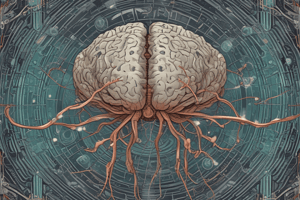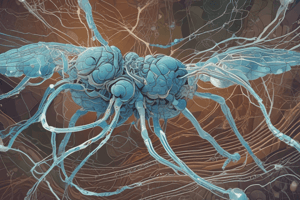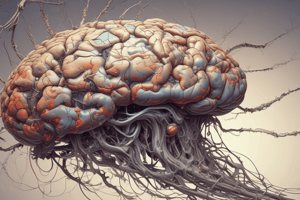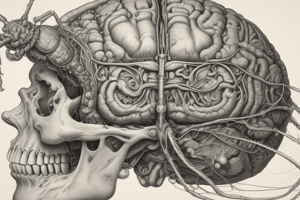Podcast
Questions and Answers
What role do the thoracic ganglia play in an insect's nervous system?
What role do the thoracic ganglia play in an insect's nervous system?
- They facilitate gaseous exchange.
- They manage olfactory learning and memory.
- They control sensory integration.
- They govern the locomotor organs and innervate muscles. (correct)
Which part of the insect's nervous system is mainly involved in olfactory learning and memory?
Which part of the insect's nervous system is mainly involved in olfactory learning and memory?
- Mushroom body (correct)
- Abdominal ganglia
- Ventral nerve cord
- Thoracic ganglia
What are spiracles in an insect's body primarily used for?
What are spiracles in an insect's body primarily used for?
- Locomotive control
- Gaseous exchange (correct)
- Muscle innervation
- Nervous signal transmission
What characterizes the abdominal ganglia in the ventral nerve cord?
What characterizes the abdominal ganglia in the ventral nerve cord?
What additional function is performed by the meso- and meta-thoracic ganglia compared to the first three thoracic ganglia?
What additional function is performed by the meso- and meta-thoracic ganglia compared to the first three thoracic ganglia?
What is the primary function of the plasmatocyte in the blood?
What is the primary function of the plasmatocyte in the blood?
Which phase of the heart's function involves the expansion of the heart?
Which phase of the heart's function involves the expansion of the heart?
What is the role of incurrent ostia in the heart?
What is the role of incurrent ostia in the heart?
What is a characteristic of the cystocyte?
What is a characteristic of the cystocyte?
What happens during the systole phase of the heart?
What happens during the systole phase of the heart?
How does haemolymph function as a lubricant?
How does haemolymph function as a lubricant?
Which type of haemocyte is described as having a distinct fat droplet?
Which type of haemocyte is described as having a distinct fat droplet?
What is the primary mechanical action of the heart for blood circulation?
What is the primary mechanical action of the heart for blood circulation?
What is the most common mechanism of sound production in the Pentatomoid groups?
What is the most common mechanism of sound production in the Pentatomoid groups?
In which group of insects is sound commonly produced by vibration of a membrane driven by muscles?
In which group of insects is sound commonly produced by vibration of a membrane driven by muscles?
What is a unique feature of sound production observed in Acherontia (Lepidoptera)?
What is a unique feature of sound production observed in Acherontia (Lepidoptera)?
What describes the type of circulatory system present in insects?
What describes the type of circulatory system present in insects?
What does the dorsal sinus contain in the circulatory system of insects?
What does the dorsal sinus contain in the circulatory system of insects?
Which substance is found between the sternum and the ventral diaphragm in the insect circulatory system?
Which substance is found between the sternum and the ventral diaphragm in the insect circulatory system?
The return of the tymbal muscle to its normal position is primarily due to what feature?
The return of the tymbal muscle to its normal position is primarily due to what feature?
What phenomenon describes the presence of three sinuses in an insect's haemocoel?
What phenomenon describes the presence of three sinuses in an insect's haemocoel?
What surrounds each ganglion and provides mechanical support for the nervous system in insects?
What surrounds each ganglion and provides mechanical support for the nervous system in insects?
What is the primary function of glial cells associated with individual nerves in the insect nervous system?
What is the primary function of glial cells associated with individual nerves in the insect nervous system?
Which segment of the insect nervous system consists of the brain and segmental ganglia?
Which segment of the insect nervous system consists of the brain and segmental ganglia?
What region of a ganglion contains the axons and dendrites of interneurons and motor neurons?
What region of a ganglion contains the axons and dendrites of interneurons and motor neurons?
What anatomical structure acts as a brain-blood barrier in the insect nervous system?
What anatomical structure acts as a brain-blood barrier in the insect nervous system?
Where does nutrient and excretion provision occur within the insect ganglia?
Where does nutrient and excretion provision occur within the insect ganglia?
What is the primary function of the tracheal system in insects?
What is the primary function of the tracheal system in insects?
Which type of nervous system in insects is primarily responsible for involuntary functions?
Which type of nervous system in insects is primarily responsible for involuntary functions?
What is the first ganglion in the insect's central nervous system called?
What is the first ganglion in the insect's central nervous system called?
Which structures connect the longitudinal tracheae between the two sides of an insect's body?
Which structures connect the longitudinal tracheae between the two sides of an insect's body?
Where does the head of an insect receive oxygen from in the tracheal system?
Where does the head of an insect receive oxygen from in the tracheal system?
What differentiates the tracheal system in Apterygota compared to most other insects?
What differentiates the tracheal system in Apterygota compared to most other insects?
Which part of an insect's body is primarily supplied by the dorsal trunks?
Which part of an insect's body is primarily supplied by the dorsal trunks?
What is the function of the constricted connecting tubes in some insects' tracheal systems?
What is the function of the constricted connecting tubes in some insects' tracheal systems?
Which structures in the tracheal system are responsible for delivering oxygen to the central nervous system?
Which structures in the tracheal system are responsible for delivering oxygen to the central nervous system?
What is the role of the tracheoles in the insect tracheal system?
What is the role of the tracheoles in the insect tracheal system?
What is the primary function of the Stomatogastric nerve system (SNS)?
What is the primary function of the Stomatogastric nerve system (SNS)?
Which part of the insect nervous system is known as the major association center?
Which part of the insect nervous system is known as the major association center?
Which ganglia are primarily involved in the control of food passage through the gut and crop emptying?
Which ganglia are primarily involved in the control of food passage through the gut and crop emptying?
What structure is associated with higher-order sensory integration and learning in insects?
What structure is associated with higher-order sensory integration and learning in insects?
How is the peripheral nerve system (PNS) characterized in insects?
How is the peripheral nerve system (PNS) characterized in insects?
What is the relationship between the optic lobes and eye size in insects?
What is the relationship between the optic lobes and eye size in insects?
What type of neurons are part of the peripheral nerve system (PNS)?
What type of neurons are part of the peripheral nerve system (PNS)?
Which of the following accurately describes the structure and components of the Central Nervous System (CNS) in insects?
Which of the following accurately describes the structure and components of the Central Nervous System (CNS) in insects?
Flashcards are hidden until you start studying
Study Notes
Brain
- Proto-, deuto- and tritocerebrum are part of the insect brain
- The mushroom body is the center for higher-order sensory integration and learning
- The mushroom body receives information mainly from the olfactory (antennal lobe)
- Hymenoptera (ants, bees, wasps, etc.) mushroom bodies also receive information from the optic lobe
- The mushroom body is involved in olfactory learning and memory, place memory, associative memory, and motor control
Ventral Nerve Cord
- It is a series of ganglia lying on the floor of the thorax and abdomen
- The ganglia are united by a pair of connectives
- Thoracic ganglia are situated one in each of the thoracic segments
- The function of the thoracic ganglia is to control the locomotor organs
- Thoracic ganglia supply a pair of nerves to general muscles and a pair of nerves to leg muscles
- Meso- and meta-thoracic ganglia control movements of wings
- Abdominal ganglia are variable in number, with their number differing between insect species
Plasmotocyte
- Plasmotocytes are a type of hemocyte
- They are responsible for phagocytosis, which is the ingestion of foreign particles and cellular debris
- Plasmotocytes help to fight off infections and maintain tissue homeostasis
Tracheal System
- The tracheal system is responsible for gaseous exchange in insects
- It consists of a network of tracheae, which are internal tubes that carry oxygen to the tissues and remove carbon dioxide
- Tracheae open to the outside through spiracles, which are segmental pores
- The tracheal system allows for efficient gas exchange, even in small insects
- The tracheal system is found in different parts of the insect's body
Stridulation in Insects
- Heteroptera commonly stridulate using files and scrapers on the ventral or dorsal surfaces of the body
- Pentatomoid groups exhibit 15 different stridulation methods
- Reduvioidea stridulate with a file between the front coxae and the tip of the rostrum
- Coleoptera often use elytra for stridulation
- Lepidoptera can create sound by rubbing veins on the wings together
Sound Production by Vibrating Membranes
- Homoptera, Heteroptera (Pentatomidae), and Lepidoptera (Arctiidae) use vibrating membranes to produce sound
- Cicada (male) tymbal muscle contracts, pulling on the tymbal to produce a click
- Relaxation of the tymbal muscle returns it to its normal position, creating a second click
- Large air sacs amplify sound
Sound Production by Pulsed Air Streams
- Acherontia (Lepidoptera) is the only known insect to use a pulsed air stream for stridulation
- Dilation of the pharynx creates a vibration in the epipharynx, generating a pulsed air stream
Insect Circulatory System
- Open circulatory system in insects
- Blood flows through the body cavity (haemocoel)
- Haemocoel divided into three sinuses by diaphragms
Haemocoel Sinuses
- Dorsal or Pericardial Sinus: Contains the heart
- Ventral or Perineural Sinus: Contains the nerve cord
- Visceral Sinus: Lies between the dorsal and ventral diaphragms
Haemocyte Types
- Prohaemocyte: Smallest cell with a large nucleus
- Plasmatocyte (Phagocyte): Aids in phagocytosis
- Granular Hemocyte: Contains numerous cytoplasmic inclusions
- Spherule Cell: Cytoplasmic inclusions obscure the nucleus, involved in blood coagulation and plasma precipitation
- Cystocyte (Coagulocyte):
- Oenocytoids: Large cells with an eccentric nucleus
- Adipo Haemocyte: Round or avoid with fat droplets
- Podocyte: Large, flattened cells with protoplasmic projections
- Vermiform Cells: Rare, long, thread-like cells
Blood Circulation
- Heart: A pulsatile organ that drives blood circulation
- Circulation is generally anti-clockwise, from the posterior end to the anterior end
- Diastole: Heart expansion, increasing heart volume and decreasing pericardial sinus area, allowing blood to enter the heart
- Systole: Heart contraction, pushing blood forward into the aorta
- Blood then enters the head and flows back to bathe visceral organs and the neural cord
- Diastasis: Short period of rest between diastole and systole
Functions of Haemolymph
- Lubricant: Keeps internal cells moist and facilitates movement of internal organs
- Hydraulic Medium: Hydrostatic pressure supports various functions, including distribution of tracheoles
Insect Respiratory System
-
Tracheal system: A network of tubes that deliver oxygen to tissues
- Tracheoles: Terminal branches of the tracheal system that end blindly or anastomose
- Located within the tissues
- Spiracles: Openings on the body surface that connect to the tracheal system
- Longitudinal Trunks: Major tracheal branches that run the length of the body
- Connect to each other through transverse commissures
- Branches: Extend to various tissues and give rise to tracheoles
- Tracheoles: Terminal branches of the tracheal system that end blindly or anastomose
-
Arrangement of Tracheal System:
- Heart and dorsal muscles supplied by branches from dorsal trunks
- Alimentary canal, gonads, legs, and wings supplied by lateral trunks
- Central nervous system supplied by ventral trunks or transverse commissures
- Head supplied by branches from spiracle 1
- Dorsal branch to antennae, eyes, and brain
- Ventral branch to mouthparts and muscles
-
Some insects have constricted connecting tubes, isolating the tracheal system of the head to ensure oxygen supply to the brain and sense organs.
Insect Nervous System
- Central Nervous System (CNS): Brain and ventral nerve cord
- Visceral (Sympathetic) Nervous System (SNS): Frontal ganglion, hypocerebral ganglion, and ventricular ganglion - Innervate muscles of the mouth cavity, foregut, and midgut - Regulate food uptake and transport
- Peripheral Nervous System (PNS): Sensory neurons located in the integument, not bundled in ganglia
Anatomy of Insect Nervous System
-
CNS: Brain (major association center) and ventral nerve cord (local association center)
- Ventral nerve cord: Subesophageal ganglion (SG), thoracic ganglia (TG), and abdominal ganglia (AG)
-
Brain: Protocerebrum, deutocerebrum, and tritocerebrum
- Mushroom body:
- Center for higher-order sensory integration and learning
- Receives input primarily from olfactory (antennal lobe) and optic lobe (in Hymenoptera)
- Involved in olfactory learning and memory, place memory, associative memory, and motor control
- Mushroom body:
-
Ventral Nerve Cord:
- Series of ganglia located on the floor of the thorax and abdomen
- Connected by pairs of connectives
- Thoracic ganglia: First three ganglia, one in each thoracic segment
- Control locomotor organs (legs and wings)
- Abdominal ganglia: Variable in number
Cerebral Development
- Brain volume varies across different insects
- Optic lobes: Develop in proportion to eye size
- Antennary lobes: Develop in relation to sensory organs and their senses
Studying That Suits You
Use AI to generate personalized quizzes and flashcards to suit your learning preferences.




